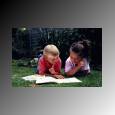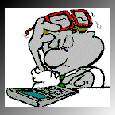

Language shapes reality. It is no wonder that the respect for the power of language has been the cornerstone of Western education for 2,500 years. We participate in that intellectual tradition, increasing our consciousness of the links between language and perception, each time we read or write.
There are three types of languages: body, sign, and the spoken. Languages help us to communicate. Infants "coo" and babble. Toddlers first words are usually "dada, baba, mom/mama". Children who are read to at an early age have good language development. Reading is the foundation for all language acquisition.

| Language Reflections |
Language learning is an ongoing, social, active process, and students need many opportunities to interact in reading, writing, listening, and speaking with each other. "Languaging" must be purposeful; language is best learned through it's use not practice. Learners need many opportunities for "languaging".
Literature has profound influences on children's laguage development. Children should be encouraged to use oral language and written activities that permit them to use more complex sentence structure in the upper elementary grades (ages 10-12).
 | Literature Reflections |
The Curriculum and Evaluation Standards for School Mathematics (K-12) by the National Council of Teachers of Mathematics (1989), an impressive document views mathematics as a means of communication and as a language system. We need to look at math the way we view reading and writing-----as a language process that children learn developmentally with much modeling, exploration, and feedback. The conditions of language learning apply to mathematical learning as well. Cooperative learning groups, teacher demonstrations, child-initiated problem solving, risk taking, and written and oral sharing need to be as much a part of the math curriculum as they are a part of the total language program.
 | Mathematics Reflections |
A vast number of schools today are making their "mark" on the www., and are allowing students to become Web authors. In doing so, students are taught to master a new language, HTML (hypertext markup language). Thus, students Web weave the connection between programming language and computers.
Check out the following "must see" sitesfor any educator or students who want to venture into Web building projects with helpful HTML examples you can download for your own use.
 |